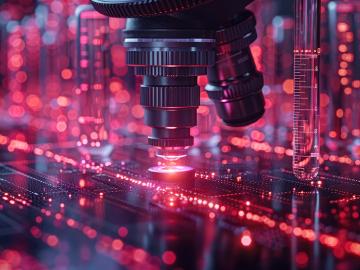Filter Results
Related Organization
- Biological and Environmental Systems Science Directorate (23)
- Computing and Computational Sciences Directorate (35)
- Energy Science and Technology Directorate (217)
- Fusion and Fission Energy and Science Directorate (21)
- Information Technology Services Directorate (2)
- National Security Sciences Directorate (17)
- Neutron Sciences Directorate (11)
- Physical Sciences Directorate
(128)
- (-) Isotope Science and Enrichment Directorate (6)
- (-) User Facilities (27)
Researcher
- Sheng Dai
- Parans Paranthaman
- Rama K Vasudevan
- Ryan Dehoff
- Bishnu Prasad Thapaliya
- Sergei V Kalinin
- Yongtao Liu
- Zhenzhen Yang
- Craig A Bridges
- Kevin M Roccapriore
- Kyle Kelley
- Maxim A Ziatdinov
- Olga S Ovchinnikova
- Shannon M Mahurin
- Ahmed Hassen
- Bruce Moyer
- Edgar Lara-Curzio
- Ilja Popovs
- Kashif Nawaz
- Li-Qi Qiu
- Michael Kirka
- Mike Zach
- Saurabh Prakash Pethe
- Stephen Jesse
- Tolga Aytug
- Uday Vaidya
- Vincent Paquit
- Vlastimil Kunc
- Adam Stevens
- Alexei P Sokolov
- Alex Plotkowski
- Alice Perrin
- Amir K Ziabari
- Amit Shyam
- An-Ping Li
- Andres Marquez Rossy
- Andrew F May
- Andrew Lupini
- Anees Alnajjar
- Anton Ievlev
- Arpan Biswas
- Ben Garrison
- Ben Lamm
- Beth L Armstrong
- Blane Fillingim
- Bogdan Dryzhakov
- Brad Johnson
- Brian Fricke
- Brian Post
- Charlie Cook
- Christopher Hershey
- Christopher Ledford
- Christopher Rouleau
- Clay Leach
- Costas Tsouris
- Craig Blue
- Daniel Rasmussen
- David Nuttall
- Debangshu Mukherjee
- Debjani Pal
- Eric Wolfe
- Frederic Vautard
- Gerd Duscher
- Gs Jung
- Gyoung Gug Jang
- Hoyeon Jeon
- Hsin Wang
- Huixin (anna) Jiang
- Ilia N Ivanov
- Ivan Vlassiouk
- James Haley
- James Klett
- Jamieson Brechtl
- Jayanthi Kumar
- Jeffrey Einkauf
- Jennifer M Pyles
- Jewook Park
- John Lindahl
- Jong K Keum
- Justin Griswold
- Kai Li
- Kaustubh Mungale
- Kuntal De
- Kyle Gluesenkamp
- Laetitia H Delmau
- Liam Collins
- Luke Sadergaski
- Mahshid Ahmadi-Kalinina
- Marti Checa Nualart
- Md Inzamam Ul Haque
- Meghan Lamm
- Mina Yoon
- Nageswara Rao
- Nedim Cinbiz
- Neus Domingo Marimon
- Nickolay Lavrik
- Nidia Gallego
- Ondrej Dyck
- Padhraic L Mulligan
- Patxi Fernandez-Zelaia
- Peeyush Nandwana
- Philip Bingham
- Phillip Halstenberg
- Radu Custelcean
- Rangasayee Kannan
- Roger G Miller
- Saban Hus
- Sai Mani Prudhvi Valleti
- Sandra Davern
- Santa Jansone-Popova
- Sarah Graham
- Shajjad Chowdhury
- Singanallur Venkatakrishnan
- Steven Randolph
- Subhamay Pramanik
- Sudarsanam Babu
- Sumner Harris
- Tao Hong
- Tomonori Saito
- Tony Beard
- Utkarsh Pratiush
- Vipin Kumar
- William Peter
- Xiaobing Liu
- Yan-Ru Lin
- Ying Yang
- Yukinori Yamamoto
- Zhiming Gao

Dual-GP addresses limitations in traditional GPBO-driven autonomous experimentation by incorporating an additional surrogate observer and allowing human oversight, this technique improves optimization efficiency via data quality assessment and adaptability to unanticipated exp

Ruthenium is recovered from used nuclear fuel in an oxidizing environment by depositing the volatile RuO4 species onto a polymeric substrate.

A novel strategy was developed to solve the limitations of the current sorbent systems in CO2 chemisorption in terms of energy consumption in CO2 release and improved CO2 uptake capacity.

This invention introduces a novel sintering approach to produce hard carbon with a finely tuned microstructure, derived from biomass and plastic waste.

The increasing demand for high-purity lanthanides, essential for advanced technologies such as electronics, renewable energy, and medical applications, presents a significant challenge due to their similar chemical properties.

The invention introduces a novel, customizable method to create, manipulate, and erase polar topological structures in ferroelectric materials using atomic force microscopy.

With the ever-growing reliance on batteries, the need for the chemicals and materials to produce these batteries is also growing accordingly. One area of critical concern is the need for high quality graphite to ensure adequate energy storage capacity and battery stability.

High coercive fields prevalent in wurtzite ferroelectrics present a significant challenge, as they hinder efficient polarization switching, which is essential for microelectronic applications.

Scanning transmission electron microscopes are useful for a variety of applications. Atomic defects in materials are critical for areas such as quantum photonics, magnetic storage, and catalysis.

Distortion in scanning tunneling microscope (STM) images is an unavoidable problem. This technology is an algorithm to identify and correct distorted wavefronts in atomic resolution STM images.

